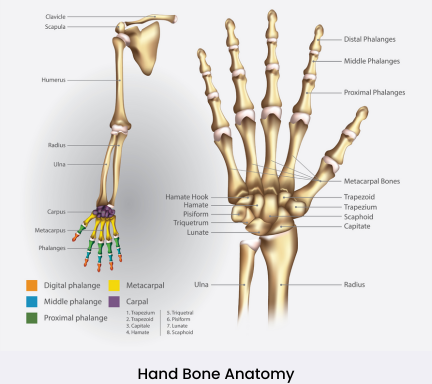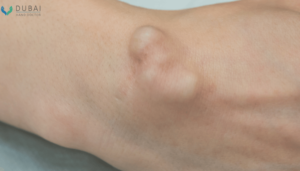What Is Scaphoid Nonunions: Symptoms, Causes And Treatments

Are you experiencing persistent wrist pain?
It could be a sign of scaphoid nonunion when the small bone in your wrist doesn’t correctly heal after a fracture.
While it may sound intimidating, understanding the symptoms, causes, and treatment options for scaphoid nonunions can help alleviate your concerns.

Understanding scaphoid nonunion
Understanding scaphoid nonunions is key to addressing this particular wrist condition. The Scaphoid is a wrist bone. It interacts with a forearm bone called the Radius to produce a large component of the wrist joint.
A nonunion scaphoid fracture occurs when the fractured bone fails to heal correctly or does not heal at all. This can happen for various reasons, such as inadequate blood supply to the area or delayed diagnosis and treatment.
It’s important to note that nonunions are more likely in certain types of fractures, particularly those that involve displacement or severe injury.
Signs and symptoms of scaphoid fracture nonunion
The symptoms listed below are not intended to be diagnostic. You should seek medical attention if you have any of these or other symptoms.
- After a fall on an outstretched hand, pain on the thumb side of the wrist.
- If left untreated, the discomfort may go away temporarily, only to return weeks or years later.
- Stiffness or swelling of the wrist.
- Heat or redness in the wrist.
The affected wrist has limited and/or uncomfortable use.
Note: Ignoring these signs could lead to further complications and potentially result in scaphoid nonunion advanced collapse (SNAC).
Diagnosing nonunion scaphoid fracture
Diagnosing a nonunion scaphoid fracture involves a combination of clinical evaluation, imaging studies, and sometimes additional tests. Here’s a general approach to diagnosing scaphoid fracture nonunion:
Clinical Assessment:
- Review of patient history and symptoms.
- Physical examination for tenderness, swelling, and range of motion.
Imaging Studies:
- X-rays to assess healing progress.
- CT scan for detailed images, especially if X-rays are inconclusive.
Additional Tests:
- MRI to evaluate blood supply and soft tissue.
- Bone scans to assess bone activity.
Timeline Assessment:
- Lack of expected progress in healing over time.
Nonunion scaphoid fracture treatment options
- If nonunion is diagnosed, treatment options may include conservative measures (such as immobilization with a cast or brace), surgical intervention (such as bone grafting or fixation), or a combination of both, depending on the case’s specific circumstances.
- Scaphoid nonunion surgery typically involves a bone graft procedure, where a piece of bone is taken from another part of the body (such as the hip or wrist) and transplanted to fill in the gap in the scaphoid bone. This helps stimulate new bone growth and promotes proper healing. Following scaphoid nonunion surgery, patients usually wear a cast or splint to immobilize their wrist for several weeks.
- Physical therapy may be recommended to regain strength and range of motion in the wrist joint.
- In some cases, internal fixation devices such as screws or plates may be used to stabilize the scaphoid bone during surgery. These devices help hold the bones together while they heal.
Consult Dr. Ehab Bassim Aldlyami for nonunion scaphoid fracture treatment
Don’t let scaphoid nonunions impact your quality of life any longer – reach out to Dr. Ehab Bassim Aldlyami today for expert guidance and personalized care.
With his expertise as the best hand doctor in the field, Dr. Aldlyami can comprehensively evaluate your hand injury, condition and recommend the most suitable treatment options for your specific case. Whether it’s conservative

Related Post

التهاب وتر اليد: الأسباب والعلاج والوقاية
أيدينا ليست مجرد أدوات عادية، بل هي أعاجيب هندسية مذهلة تسمح لنا بفهم العالم والتفاعل

Understanding Wrist Ganglion/Ganglia: Causes, Symptoms, and Diagnosis
Understanding Wrist Ganglion Cysts : Ganglion cysts are a common benign condition that can affect

Hand Tendon Injuries: Causes, Treatments, and Prevention
English Our hands are engineering marvels, allowing us to grasp, manipulate, and interact with the

تعّرف علي اعراض كسر اليد و التواء الرسغ والفرق بينهما
هل سبق لك أن سقطت على يدك الممدودة وشعرت بألم حاد في معصمك؟ إذا كان

What is the most common peripheral nerve injury?
Peripheral nerve injuries are prevalent and can be quite debilitating, affecting many people each year.

اسباب الم اليد وكيف تختار طبيب اليد المناسب
هل تعاني من ألم مزعج في اليد لا يختفي؟ ألم اليد ليس مجرد شكوى، بل




